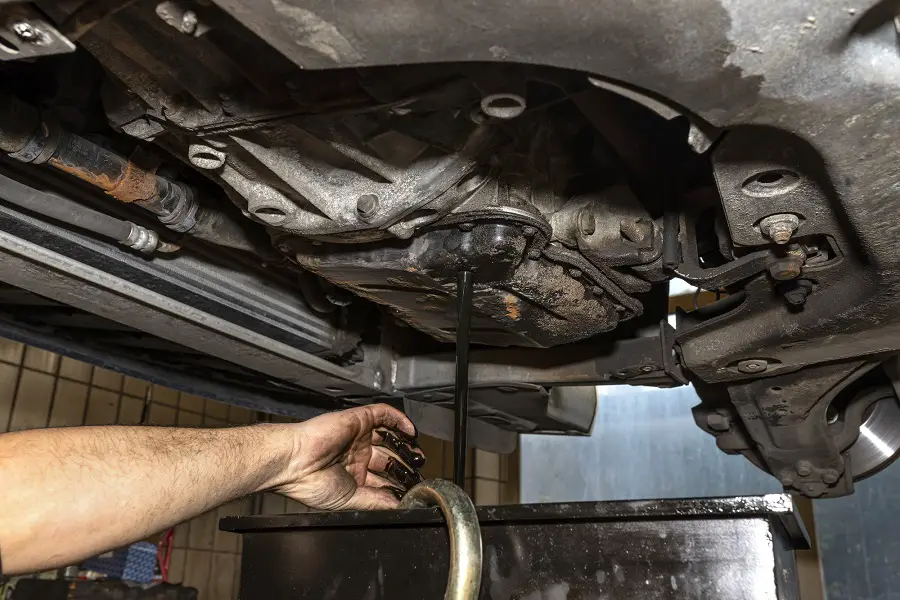Checking your vehicle’s transmission fluid should always be a step in your regular preventative maintenance routine. But, there are a few factors to consider before you start pulling out dipsticks left and right.
Learning how to check and change transmission fluid is easy, and any amateur mechanic can tell you that performing your own regular maintenance on your car can save you hundreds (or even thousands) of dollars each year.
In this guide, we’ll teach you how to check your transmission fluid and briefly explore the full transmission fluid change process.
But remember that safety is the most important part of vehicle maintenance. If you’re new to car maintenance or don’t have the proper equipment, let a professional mechanic handle the more difficult maintenance procedures.
Checking Automatic Transmission Fluid
There are a few crucial steps you need to take before you can check your vehicle’s transmission fluid levels and condition:
- Your vehicle must be on a level, hard surface.
- Your engine must be at operating temperature (transmission fluid takes time to warm up).
- For manual transmissions, your car must be in neutral with the parking brake engaged.
For certain makes and models, the engine must be running and at operating temperature to get an accurate reading. However, other makes and models simply require the vehicle to be at operating temperature and the engine can be turned off.
To determine whether or not your car’s engine needs to be running in order to check the transmission fluid, consult your car’s owner’s manual or service manual. If these documents weren’t included with your car, you can find most manuals online.
Once your car has reached operating temperature (you can check the temperature gauge on your instrument panel to confirm), locate your dipstick. Most cars have at least one dipstick, but if your car only has one, it’s likely to check the level and condition of the motor oil, not the transmission fluid.
Make sure to consult your owner’s manual or read any writing on the dipstick handle to make sure you’ve found the correct one.
Once you’ve found the transmission fluid dipstick, completely remove it from the engine, wipe it clean, and replace it completely into the engine. Make sure the dipstick is completely re-inserted before removing it again.
Remove the dipstick and check the level and condition of the oil. There are a few different kinds of dipsticks:
- Some have hatch marks and writing to indicate the fluid level.
- Others have a few punched holes but no writing.
- Some have a ruler with notches.
Consult your manual to learn how to read your transmission fluid dipstick. You’ll want to check both the level and the condition of the fluid. While the fluid level should reach (or be close to) the indicated mark on your dipstick, it should also be a pinkish color. Even if you have enough fluid, if it’s brownish or greyish, it’s time for it to be replaced.
Where Is Your Dipstick? Two General Scenarios
When learning how to check and change transmission fluid, the most important step is finding your dipstick or lack thereof. Some modern vehicles have a normal dipstick, while others have a sealed transmission system without a dipstick.
Visible with a Colored Handle
If your vehicle has a dipstick for the transmission, it should be relatively easy to find. Consult your owner’s or service manual to find it if a quick peek under the hood leaves you stumped.
Your dipstick will be visible, and it will have a colored handle. In some cases, the handle will be labeled. Simply perform the steps above to check your fluid levels and condition.
Fill and Drain Plugs Instead of a Dipstick
Some modern vehicles have a sealed transmission system, meaning there isn’t a dipstick for home mechanics to use to check the fluid levels and condition.
Sealed transmissions tout transmission fluid that will last the entire lifespan of the transmission, but this new technology is still being refined and perfected. So, if you notice crunching when you shift gears or other transmission troubles, you may want to check the transmission fluid in your sealed system anyway.
Instead of a dipstick, sealed transmissions have two plugs: a fill plug and a drain plug. They’re usually located on the top of the transmission, which is normally halfway between the two front wheels and immediately in front of your car’s firewall (also called a bulkhead).
To check, drain, and fill the transmission fluid on a sealed transmission, you have to use jacks or a lift to raise your vehicle off the ground. This is a dangerous process, so it’s best to consult a mechanic for maintenance of a sealed system.
When in Doubt, Consult the Manual
If you can’t find your dipstick or you’re having trouble identifying your transmission system, it’s always helpful to consult your owner’s manual or the service manual.
These are usually available online, and a local dealership can help you find accurate manuals for your make and model.
Changing Transmission Fluid
Changing your transmission fluid could be necessary even if you have enough. If your fluid isn’t pink, viscous, and free of debris, it’s time to replace it.
In this section, we’ll provide some general steps for a full transmission change, not a flush. Mechanics use a specialized machine that pumps out the old fluid and adds new fluid during a transmission flush, but this section focuses specifically on a fluid change on a traditional (not sealed) transmission.
First, use jacks or a lift to raise your vehicle off the ground. Use extreme caution. Then:
- Identify and remove the transmission fluid pan (which will sometimes be covered by a dust protector).
- Remove the filter inside of the pan, and have a new one ready to install.
- Remove the old gasket, and replace it with a new one.
- Once you’ve replaced the filter and gasket, reinstall the transmission fluid pan (and the dust cover, if applicable).
- Remove the dipstick, clean it, and add new transmission fluid with a funnel.
Throughout the process, remember to always consult manuals. If you think you’re in over your head, consult with a professional mechanic. Home vehicle maintenance isn’t for everyone, and there’s no shame in letting the professionals do what they do best.






